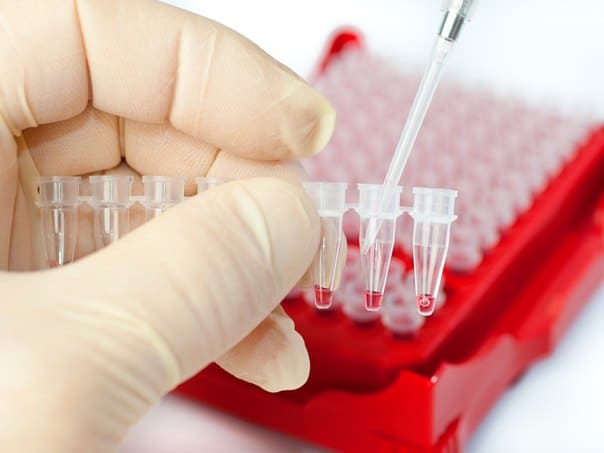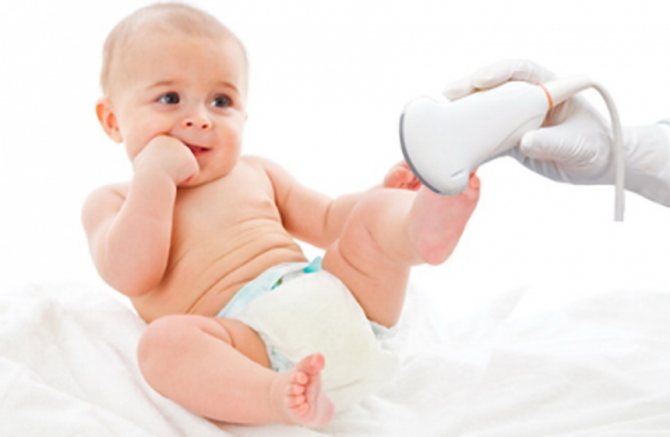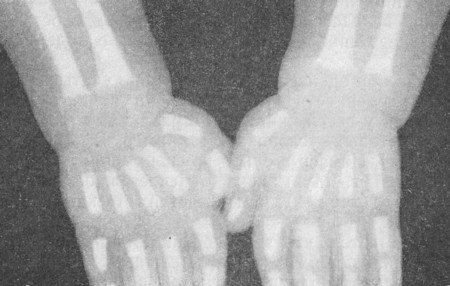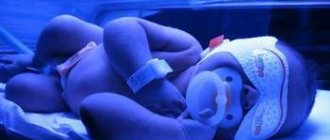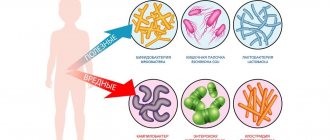About the disease
Congenital hypothyroidism is a disease that can be caused by various reasons, but in any case leads to a decrease or complete loss of thyroid function.
According to statistics, the disease is not rare, it occurs in one baby out of 4 - 5 thousand newborns and is one of the most common diseases of the endocrine system in children. Female representatives are more susceptible to this pathology; manifestations of the disease are observed in them 2 times more often than in boys. With hypothyroidism, the thyroid gland cannot properly perform its function, which significantly affects the health and development of the baby.
Classification of hypothyroidism
Hypothyroidism can be congenital or acquired. Congenital hypothyroidism is often observed in newborns who are born with insufficient hormone production. The frequency of the congenital form of the pathology is approximately 1 case per 4-5 thousand children. Most often this pathology occurs in girls. Depending on the severity, hypothyroidism can be:
- transient;
- subclinical;
- manifest.
Depending on the degree of disruption of hormone production, there are several stages of this disease in a child.
What is the role of the thyroid gland in the body?
This internal secretion organ is a source of three types of hormones: thyroxine (T4), triiodothyronine (T3), calcitonin. The first two (T3, T4) contain iodine, and their role in the child’s body largely depends on the age of the baby.
In the perinatal period and early childhood, these biologically active substances are necessary for the proper development of the baby, especially his skeletal system and central nervous system organs. In adults, thyroid hormones are involved in many metabolic processes and provide mental functions such as memory, speed of reflex reactions, and others.
In addition to iodine-containing biologically active substances, the thyroid gland produces the peptide hormone thyrocalcitonin. This substance actively participates in mineral metabolism, maintains the necessary concentration of calcium and phosphorus, and promotes the formation of the normal composition of bone tissue and teeth.
How does congenital hypothyroidism occur in children?
The formation of organs and systems of the fetus, its growth and development occurs mainly due to maternal hormones, which enter the baby’s body through the placenta. Therefore, newborns with hypothyroidism usually do not differ significantly from other children and do not have signs of significant pathology of the internal organs.
Problems for the baby arise after birth, when the hormones received from the mother begin to be destroyed, and their own biologically active substances are not synthesized. In healthy children, thanks to these substances, the formation of brain cells and the development of mental functions occur.
For the normal development of the child’s central nervous system, it is necessary to have a sufficient amount of T3 and T4 in the body. If in infancy the baby has a deficiency of thyroid hormones, then mental retardation (cretinism) is formed, which is irreversible, the normal formation of the skeleton is disrupted, and pathologies of other organs arise.
Causes
The thyroid gland begins its formation in the middle of the second month of pregnancy. Around the 10th week, she begins to produce hormones on her own. If the hormonal activity of the thyroid gland is not able to fully satisfy all the needs of the growing fetus or hormones are not produced at all, then various malformations may occur.
Hypothyroidism in newborns can occur for reasons such as:
- genetic predisposition;
- the mother’s diet does not contain enough iodine-containing foods;
- treatment of the thyroid gland in the mother during pregnancy;
- fetal thyroid injury;
- environmental pollution;
- increased background radiation;
- infectious diseases of the child and mother.
The congenital form and acquired hypothyroidism in children under one year of age differ in that the acquired form occurs after birth, and this occurs mainly due to autoimmune processes in the body.
Classification and causes of congenital hypothyroidism
Depending on the factor that caused the disease, the disease is divided into several types.
Primary hypothyroidism (thyroidogenic)
Most often (about 90% of all cases of the disease), manifestations of the disease occur due to defects in the formation of the thyroid gland itself during intrauterine development. Ectopia (its incorrect location) accounts for about 30–45% of ailments. Agenesis (absence of part of an organ) accompanies 35–45% of cases of pathology, and hypoplasia (reduction in the overall size of the gland) is less common, about 5% of the total number of diseases.
The most common causes of primary hypothyroidism are considered to be unfavorable environmental factors - exposure to radiation and iodine deficiency in the expectant mother. Some intrauterine infections can also negatively affect the development of thyroid tissue.
It is possible that there may be a toxic effect of some medications that enter the fetus’s body in utero - thyreostatics, tranquilizers and other drugs. In a number of cases, there were autoimmune pathologies in the mother and endemic goiter.
It is believed that a small number of primary hypothyroidisms are hereditary and associated with a gene defect in the baby's body. Typically, in such cases there are signs of congenital pathologies of many organs and systems (for example, heart defects, structural anomalies of the palate and upper lip, and others).
Secondary (pituitary)
The disease is associated with pathology of the brain, more precisely the adenohypophysis, where thyroid-stimulating hormone is synthesized. This substance normally regulates the formation of thyroid hormones and maintains their normal concentration in the body.
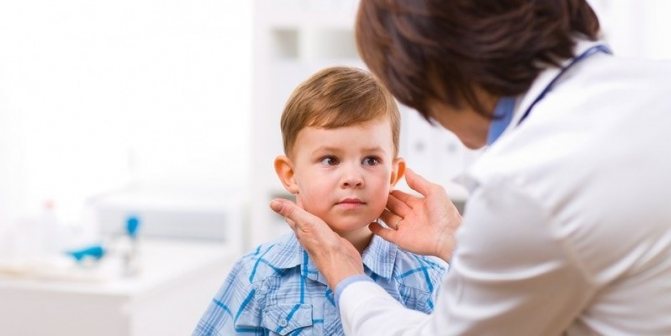
Typically, such disorders occur in cases of combined pathologies of many hormones secreted by the anterior pituitary gland (GH, ACTH, FSH and others) and are more often observed with organic damage to the brain. For example, with abnormalities in the development of the central nervous system, severe birth trauma or asphyxia, tumor formation.
Tertiary hypothyroidism (hypothalamic)
The cause of the pathology in this case also lies in the functioning of the brain, but unlike secondary forms, it is located in the hypothalamus. These structures normally regulate the functioning of the pituitary gland and together with it form the hypothalamic-pituitary system.
Therefore, experts classify secondary and tertiary forms of the disease as central hypothyroidism (associated with abnormal functioning of the central nervous system).
Peripheral form (transport, tissue)
The disease can develop not only due to pathology associated with the release of necessary hormones. It happens that initially a sufficient amount of biologically active substances is formed in the body, the sensitivity of tissues to them is impaired (usually this is due to the pathology of certain receptors).
Sometimes a child has a pathology in the formation or metabolism of thyroid hormones. Such situations in most cases are hereditary in nature.
Diagnostics
There are certain difficulties in early detection of the disease due to the following factors:
- the impossibility of prenatal determination of pathology due to the low connection with hereditary factors and it is impossible to take fetal blood for diagnosis (percutaneous sampling is dangerous and is not performed for this purpose);
- no genetic markers found;
- it is not possible (at the moment) to reliably predict the birth of a child with congenital hypothyroidism in healthy women;
- latent period of the disease in the first months after birth.
Note. Compared to other congenital pathologies, hypothyroidism is relatively easy to treat with medication.
The main diagnostic procedures are presented in the table, and more details about them and the problem of identifying pathology in children can be seen in the video provided in this article.
Table. Diagnosis of hypothyroidism in newborns:
| Method | Explanation |
| Biochemistry determines TSH in the blood (normal is 20 µU/ml). If the thyroid-stimulating hormone exceeds the permissible values, the child is subject to detailed diagnostics and constant dynamic monitoring. For infants older than 90 days, there may be increased levels of low-density lipoprotein and cholesterol. Clinical examination may show signs of anemia. |
| Examination of the thyroid gland is indicated to determine the nature of changes in the thyroid gland. |
| The child's wrist joints are examined. In the photo you can visualize the lag in their ossification from the norm. |
| Registers slow pulse (bradycardia) and wave voltage. |
When making a diagnosis, clinicians and doctors must differentiate hypothyroidism in newborns from the following pathological conditions:
- rickets;
- congenital dysplasia of the pelvic and hip joints;
- heart defects;
- Down syndrome;
- hepatitis;
- anemia;
- injuries received during childbirth.
At an older age, the differential diagnosis should exclude such pathological conditions as Hirschsprung's disease, chondrodysplasia, mucoplisaccharidosis and others.
Note. The price of a screening examination is 4–5 times cheaper than diagnosis after the manifestation of clinical signs.
How does the disease manifest?
Manifestations of the disease largely depend on the form and severity of the disease. With a pronounced lack of hormones, the disease can be suspected immediately after the baby is born. But such situations arise infrequently, about 5% of cases; in general, children with a congenital disease do not differ significantly from other children.
Signs of the disease usually develop gradually, starting from the 7th day of the baby’s life. But this gap may increase if the baby receives a small amount of the hormones it needs through breast milk. Some manifestations of the disease, although not specific, their combination may indicate congenital hypothyroidism already in the first weeks of a baby’s life.

Symptoms in newborns, due to which one can suspect the disease:
- post-term pregnancy;
- The baby's body weight at birth is about 4 kg;
- swelling of the child's face;
- open small fontanel;
- signs of decreased tone;
- enlarged tongue;
- the presence of an umbilical hernia;
- pale, dry skin or development of neonatal jaundice that lasts more than 3 weeks.
The characteristic manifestations of the disease develop gradually, and the symptoms of hypothyroidism without adequate treatment become more and more pronounced. Already by 3–6 months, the baby begins to show typical signs of the disease.
The baby will appear swollen, because due to a lack of hormones, fluid is easily retained in the tissues. The child’s face appears rough, the palpebral fissures are narrow, but the palpebral fissures are wide, and the development of the facial skeleton is delayed. Noteworthy is the enlarged tongue, which becomes clearly visible due to the constantly slightly open mouth.
If the disease develops, the color of the skin also changes, a jaundiced or grayish tint appears. The baby's hair becomes brittle and dry, and the nail plates atrophy. The child's voice acquires a low timbre, seems hoarse and rough. Cyanosis often occurs around the baby's lips, and the breathing rhythm is disrupted.
Developmental delay becomes noticeable, the baby does not master the skills necessary for this age, apathy appears, and the baby does not show interest in the world around him. The older the child gets, the more pronounced the signs of retardation in intellectual and mental development.
Mental retardation in children with congenital hypothyroidism is irreversible. Therefore, timely initiation of hormonal therapy is very important in the prevention of complications.
These children are prone to low body temperature, chilliness, and their limbs are often cold. Children start teething later and their fontanelles do not close for a long time. Babies with hypothyroidism may have a slow pulse, low blood pressure, and an enlarged heart.
As the child grows up, these symptoms progress, and a severe delay in intelligence and mental development is formed. The rate of ossification of the skeleton and the formation of secondary sexual characteristics are slowed down, due to the presence of significant endocrine problems.
Symptoms in newborns
In newborns, the disease can be suspected if the baby is born from the mother at 40–42 weeks of gestation. Signs of hypothyroidism in a child:
- prolonged jaundice;
- large birth weight 3.5–4 kg;
- late closure of the fontanel;
- half-open mouth with a wide tongue;
- low crying, similar to a hoarse voice due to swelling of the vocal cords;
- delayed healing of the umbilical wound;
- decreased body temperature, which is manifested by cold hands and feet;
- sluggish sucking reflex;
- slow heart rate;
- swelling of the face and eyelids, tongue, and fingers.
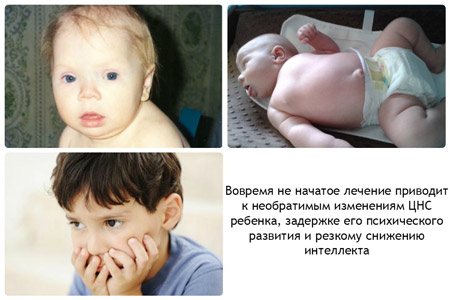
With a mild form of the disease in the congenital period, the symptoms are not always regarded by doctors as endocrine pathology.
Attention! When breastfeeding, symptoms are smoothed out by receiving hormones from the mother through milk. As the baby develops, thyroid symptoms increase.
In children under one year of age, symptoms of hypothyroidism become obvious. There is a delay in psychomotor development. The baby is lethargic, inactive, and is lagging in height and weight. His fontanel closes late and his teeth erupt. It is difficult for a child to acquire the skills of sitting, crawling, and standing on his feet.
Children with hypothyroidism are indifferent to the world around them, do not make contact, and do not pronounce individual syllables. Kids differ from their peers in appearance.
The skin is dry, the hair is brittle and lifeless, and the body temperature is reduced. Constipation is observed in the digestive system. Peripheral blood analysis reveals a decrease in hemoglobin, and anemia develops.
As for the prenatal period of development, the embryo is formed with deficiencies in brain development with the subsequent development of cretinism and dwarfism. In addition, the formation of the genital area is disrupted. The skeleton is deformed, there is a decrease in hearing and speech up to deaf-muteness.
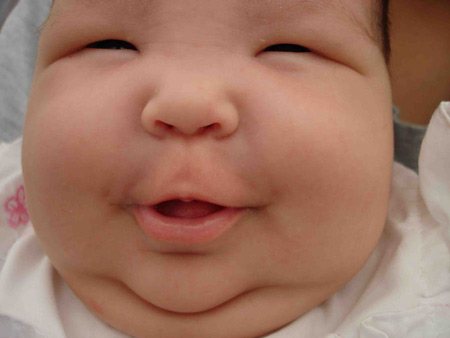
Diagnosis of the disease
Neonatal screening
Important! The baby may not have any clear signs of the disease after birth, and the clinical picture develops gradually, irreversibly disrupting the child’s development. Therefore, the time of diagnosis is of great importance in the effectiveness of treatment and prognosis of the disease.
In order to promptly recognize a dangerous illness in the maternity hospital, all newborns undergo a special examination - screening for hereditary diseases. This is an absolutely free procedure that involves taking 5 drops of blood from the baby’s heel onto filter paper to diagnose hereditary diseases, including congenital hypothyroidism.
During neonatal screening in Russia, 5 genetic diseases are determined - phenylketonuria, congenital hypothyroidism, adrenogenital syndrome, cystic fibrosis and galactosemia. These diseases may not have any manifestations in a newborn, but without proper treatment they can lead to irreversible retardation in mental and physical development.
During the examination of a dry drop of blood for hypothyroidism, the level of thyroid-stimulating hormone of the pituitary gland (TSH) is determined, which increases compensatory with a decrease in thyroid hormones of the thyroid gland. Positive screening results for this disease may be a basis for prescribing hormone replacement therapy.
Sometimes an increase in TSH may indicate transient hypothyroidism in newborns - a condition that can be caused by iodine deficiency, prematurity, diseases of newborns (intrauterine infections, sepsis, malnutrition), diseases of the thyroid gland in a woman during pregnancy. This form of the disease is highly treatable and is temporary.
Physical examination
In cases where the signs of the disease were not recognized during the neonatal period, the baby develops typical manifestations of the disease. The appearance of the baby changes, and attention is drawn to apathy, developmental delays, hypotension, and decreased body temperature in the child.
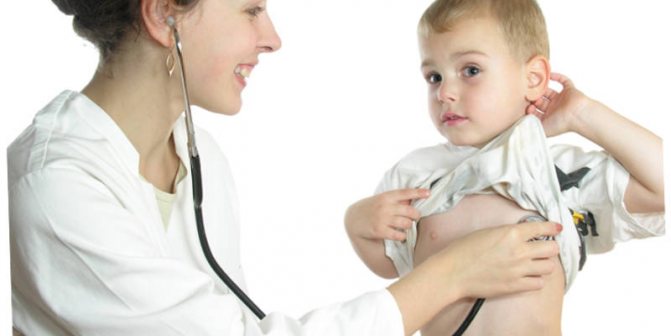
Laboratory research
To clarify the form of the disease and determine the necessary therapy, it is recommended to study the child’s hormone levels. The most informative is the repeated change in TSH and T4 (thyroxine) in the blood plasma.
Indirectly, congenital hypothyroidism can be indicated by normochromic anemia in a clinical blood test, an increase in the amount of lipoproteins and cholesterol during a biochemical study.
Instrumental methods
These methods become informative when the baby develops a clear clinical picture of the disease. Using radiography, delayed ossification and epiphyseal dysgenesis can be detected. The ECG shows signs of a slow heart rate and a decrease in voltage.
Blood pressure in such babies is usually below normal, and ultrasound of the thyroid gland often reveals signs of a disorder in the structure of the organ. Changes detected during computed tomography and magnetic resonance imaging may indicate damage to the brain and hypothalamic-pituitary system.
Hypothyroidism in newborns
13.09.2019
Thyroid examination is one of the screening tests for newborns. An examination of the thyroid gland can detect endocrine gland disorders, such as, for example, congenital hypothyroidism . According to scientific research, girls with thyroid suffer twenty times more often than boys. The thyroid gland is the largest endocrine gland in the human body. In children it weighs about 4–15 g, while in adults it weighs 15–30 g. The thyroid gland produces hormones that control body temperature and metabolic processes. Proper functioning of the thyroid gland affects the nervous, digestive and reproductive systems. In infants, thyroid affect the slowdown of the child’s development and growth and the formation of the skeletal system.
Hypothyroidism in a newborn
If the thyroid gland produces too little hormone relative to the body's needs, it is called hypothyroidism . Hypothyroidism can be caused by abnormal hormone or abnormal development of the thyroid gland . In children, congenital hypothyroidism is the most common. In this case, thyroid gland is not able to produce enough hormones . Congenital hypothyroidism is not always diagnosed during pregnancy because the deficiency of fetal hormones hormones produced by thyroid gland . In some cases, hypothyroidism in children is caused by an underactive thyroid gland , which is manifested by physical problems such as a widening of the tongue.
The main symptoms of congenital hypothyroidism in newborns are:
- prolonged jaundice of newborns;
- slow intestinal motility and frequent constipation and abdominal ;
- long sleep time for the newborn and low activity of the child;
- lack of appetite;
- newborn crying;
- decreased muscle tone.
Hypothyroidism in children can manifest itself as delayed growth of teeth and bones , while hypothyroidism in adolescence mainly manifests as delayed puberty and learning problems. Hypothyroidism in newborns most often occurs as a result of genetic disorders or hormone in the mother. In older children, thyroid can be caused by a lack of iodine or medications. Congenital deficiency thyroid hormones in a child can lead to mental retardation and dwarfism because the thyroid gland is responsible for the proper development of tissues, especially bone tissue. Hypothyroidism , which occurs in a child over two years of age, usually develops without signs indicating mental retardation. However, growth retardation and learning problems are common.
Diagnosis of hypothyroidism in newborns
Diagnosis of hypothyroidism in newborns is based on clinical symptoms and blood tests by a specialist on the third day of life, which determine the level of TSH (thyrotropin - hormone that stimulates the thyroid hormone to hormonal activity). A high TSH level usually indicates hypothyroidism . The TSH standard for newborns is below 15 mU/L on the fourth day after birth . In newborns, the concentration of TSH is significantly increased until the fourth day after birth, which is a completely natural phenomenon. Hashimoto's disease can cause congenital hypothyroidism due to abnormalities in the immune system. The child's immune system attacks the thyroid gland , resulting in disruption of the production thyroid hormones .
Neonatal screening for thyroid is carried out in neonatal units. However, making a diagnosis is not easy. If a mother notices alarming changes in her child after leaving the hospital , she should inform the doctor . Anxiety should be caused by symptoms such as pale and dry skin , low mobility of the child, drowsiness, frequent constipation and difficulty passing stool, slow growth. These are symptoms that may indicate hypothyroidism in a child. Treatment of hypothyroidism in children involves the administration of appropriate replacement medications that complement the deficiency thyroid hormones . Early diagnosis of the disease and treatment ensure the child’s normal psychophysical development.
Published in Diseases of the endocrine system Premium Clinic
Treatment of the disease
Substitution therapy is prescribed immediately after diagnosis. Treatment can begin as early as 8–9 days of the baby’s life, when its effectiveness is maximum. This disease is an absolute indication for the use of hormonal therapy with levothyroxine.
A delay in the start of treatment for more than 1 month may lead to disturbances in the mental and physical development of the baby.
Therapy of the disease is carried out under the control of the level of hormones in the blood (TSH, T4), and regular laboratory examination of the baby. It is possible to prescribe symptomatic therapy, vitamin and mineral preparations in the complex treatment of hypothyroidism.
Treatment

A drug to compensate for congenital hypothyroidism in newborns
The child is observed by several doctors at once: a pediatrician, a cardiologist, a neurologist and an endocrinologist. Replacement therapy is carried out with levothyroxine sodium or its analogues (L-thyroxine-Farmak, eutirox, L-thyroxine-Acri and others), which is deposited and converted into active T3.
Treatment is likely to be lifelong, but it does not present any special difficulties or developmental disabilities. After a single dose (the instructions require this to be done in the morning), the concentration of the active substance in the body remains at the required acceptable level throughout the day.
The dosage of levothyroxine sodium is selected strictly individually and is subsequently adjusted based on the results of dynamic diagnostics. The initial dose is usually 10–20 mcg/day. (the child’s need for hormones correlates with the surface of the body), after which it is brought to optimal. The correctness of the chosen concentration is indicated by the absence of a clinical picture and normal TSH values in the biochemical blood test. Complex therapy for hypothyroidism in newborns involves the administration of vitamins.
Control blood tests for hormone levels are carried out 14 and 45 days after the start of compensation. In the first 12 months of life, they focus on T4, because TSH cannot be considered as the only criterion, since it is in correlation.
If this feature is not taken into account, an overdose of sodium levothyroxine is possible. Therefore, the dosage of replacement therapy can be considered correct when TSH is elevated and free thyroid hormones of the thyroid gland are normal. Starting from the second year of life, blood tests are done about once every 3-4 months.
The note. Even in doubtful cases, replacement therapy is prescribed. After the diagnosis is clarified, the doses are adjusted or the medicine is discontinued altogether.
The chemical composition of levothyroxine fully corresponds to natural human thyroxine (in terms of biochemical composition), which puts the drug in first place among other drugs used for pathological conditions of this kind.
It is important to note that after taking the tablet (in the morning, half an hour before meals, in crushed form for very young patients when feeding milk), a so-called depot is created in the blood, from which hormones will be selected throughout the day for the body’s needs. This allows you to completely compensate for the lack of thyroxine and avoid excessive levels of triiodothyronine in the blood.
Prognosis and prevention
The course of the disease largely depends on the timeliness and quality of treatment. If replacement therapy is prescribed on time, the child develops according to age standards. Usually, babies have to take hormonal medications for life.
In cases where there is a delay in the prescription of treatment (especially if the interval is 3–6 months), the child develops irreversible impairments of intellectual functions, including mental retardation, damage to the skeletal system and a slowdown in metabolism.

Prevention of the disease consists of timely treatment of thyroid diseases in a pregnant woman, sufficient iodine intake in food during pregnancy, and neonatal screening.
Forecast
When treatment is started early, the prognosis is generally favorable. Hormone replacement therapy leads to rapid compensation of the sick child’s condition and subsequently his psychomotor development occurs in accordance with age-related characteristics.
If replacement therapy is prescribed after the child develops signs of cretinism, it can only prevent their further progression. In such cases, the child experiences irreversible and profound changes leading to disability.
Children suffering from hypothyroidism are under constant supervision of an endocrinologist, pediatrician, and neurologist. They should measure the level of thyroid-stimulating hormone in the blood at least once a quarter.
Hypothyroidism in children causes significantly more serious consequences than in adults. The younger the child, the greater the danger a deficiency of thyroid hormones poses to his health.
conclusions
Congenital hypothyroidism is one of the most common endocrine diseases in childhood.
This disease can cause serious problems for the health of the baby and lead to irreversible consequences. At the same time, timely detection and treatment of the disease ensures the normal development of the child and a minimum number of manifestations of the disease. It is important for parents to understand the importance of early diagnosis and adequate treatment of the disease and not to refuse neonatal screening, because the health of the baby in the future depends on it.
